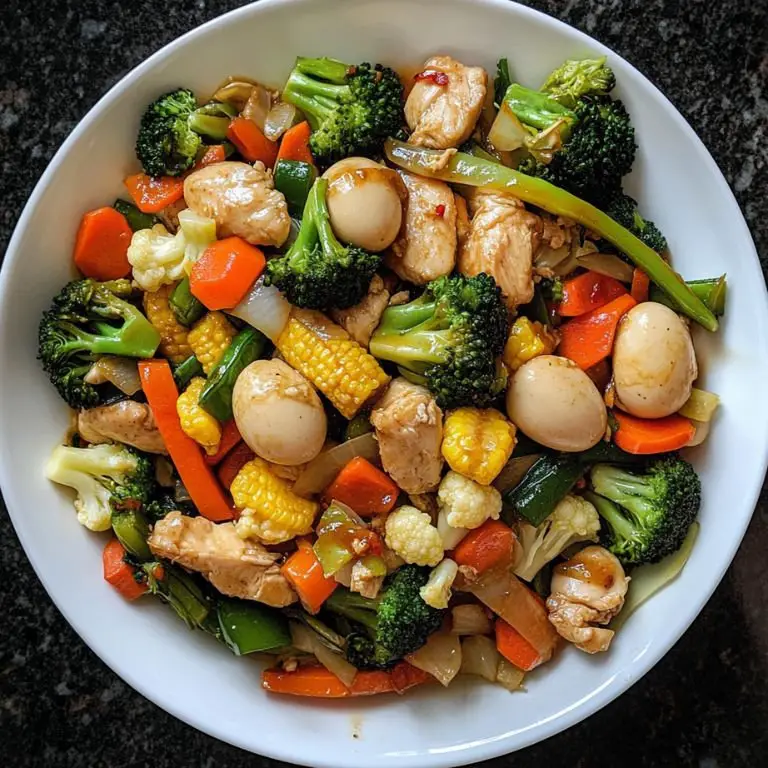If there's one dish that perfectly blends the hearty, homey soul of Filipino cuisine with vibrant Chinese influence, it's got to be Filipino Chicken Chopsuey with Quail Eggs. This colorful stir-fry is a staple at celebrations, potlucks, and Sunday lunches, and it’s easy to see why. Loaded with crisp-tender vegetables, tender chicken, and those delightful little orbs of quail eggs, this dish brings both nostalgia and nourishment to the table. It’s like a warm hug on a plate, and if you grew up on Filipino vegetable recipes, this one's probably made several appearances on your dining table.
Filipino Chicken Chopsuey with Quail Eggs
Prep Time 25 minutes mins
Cook Time 20 minutes mins
Total Time 45 minutes mins
Course Main Course
Cuisine Filipino
Wok or large skillet The high sides are perfect for tossing and sautéing. A deep frying pan will work in a pinch.
Chopping board and sharp knife For prepping all those fresh veggies.
Mixing bowls For marinating the chicken and mixing sauces.
Medium pot To boil the quail eggs separately.
Tongs or wooden spatula To stir and toss without breaking delicate vegetables.
- 500 g boneless chicken breast or thigh sliced thinly (thigh for more flavor, breast for a leaner option)
- 1 tbsp cornstarch
- 1 tbsp soy sauce
- 1/2 tsp ground black pepper
- 2 tbsp vegetable oil
- 4 cloves garlic minced
- 1 medium onion sliced thin
- 1 small head of cauliflower cut into florets
- 1 small head of broccoli cut into florets
- 1 cup snow peas sitsaro
- 1 medium carrot julienned
- 1 red bell pepper sliced into strips
- 1/2 cup baby corn sliced
- 1 cup cabbage roughly chopped
- 12 quail eggs hard-boiled and peeled
- 1 1/2 cups chicken broth
- 2 tbsp oyster sauce
- 1 tbsp fish sauce patis
- Salt and pepper to taste
- 1 tbsp cornstarch mixed with 2 tbsp water slurry for thickening
Marinate the Chicken
In a bowl, toss your sliced chicken with soy sauce, black pepper, and 1 tbsp cornstarch. Set aside for 10–15 minutes while you prep the veggies.
Prep the Quail Eggs
Boil the eggs for about 4–5 minutes, then transfer to cold water and peel. Set aside.
Heat the Oil
In your wok or large skillet, heat the vegetable oil over medium heat. Sauté garlic and onion until aromatic and translucent.
Cook the Chicken
Add marinated chicken to the pan and stir-fry until no longer pink. Remove from the pan and set aside.
Sauté the Veggies
In the same pan, add a splash of oil if needed. Toss in carrots, cauliflower, and broccoli first since they take longer to cook. Stir-fry for 3–4 minutes.
Add Remaining Vegetables
Mix in snow peas, bell pepper, baby corn, and cabbage. Cook for another 3 minutes, stirring frequently.
Combine and Simmer
Return the cooked chicken to the pan. Pour in the chicken broth, oyster sauce, and fish sauce. Bring everything to a simmer and let it cook for about 3 minutes so the flavors meld.
Thicken the Sauce
Add the cornstarch slurry and stir gently until the sauce thickens and glazes the veggies.
Finish with Quail Eggs
Gently mix in the boiled quail eggs. Cook for 1 more minute, just to warm them through.
Season and Serve
Adjust salt and pepper to taste. Serve hot over steamed rice or even Filipino noodles like pancit for a hearty pairing.
What to Pair It With
Rice
Nothing beats hot, freshly steamed jasmine rice to soak up that flavorful sauce.
Noodles
Serve it over pancit canton or bihon for a fusion of Filipino noodle classics with your veggie stir-fry. You might even find yourself leaning into an authentic pancit recipe Filipino families have passed down for generations.
Spring Rolls or Okoy
For crunch, try pairing it with lumpiang shanghai or okoy—a savory fritter made with shrimp and vegetables, another pinoy recipe favorite.
A Light Soup
Something simple like miso soup or a clear chicken broth can round out the meal without overpowering the rich flavors of the chopsuey.
FAQs
1. What part of the chicken works best for chopsuey?
Thighs offer more flavor and remain juicy, while breasts are leaner and cook faster. Either works, but thighs are especially forgiving if you’re worried about overcooking.
2. Can I use other proteins?
Absolutely. Swap chicken for shrimp, tofu, or even slices of pork for a pork chop suey spin. The key is to not overcook the protein to keep it tender.
3. Is this the same as Chinese chop suey?
This version is rooted in a chopsuey recipe Filipino cooks have adapted, which leans toward a saucier, more vegetable-forward dish compared to the drier Chinese chop suey versions. Still, the lineage is clear—it’s one of the most beloved Filipino adaptations of a chop suey recipe Chinese in origin.
4. Can I make it vegetarian?
Definitely. Omit the meat and quail eggs, and add tofu or mushrooms instead. You’ll still end up with a delicious vegetable chop suey, one of the tastiest gulay recipe Filipino food variations.
5. What other dishes go well with it?
If you're putting together a Filipino spread, include some siomai, pancit, or lumpia. These Filipino dishes recipe options bring variety to your meal and keep things exciting.
6. How do I store and reheat it?
Keep leftovers in an airtight container in the fridge for up to 3 days. Reheat in a skillet with a splash of water or broth to loosen the sauce. The quail eggs reheat well but should not be overcooked again.
